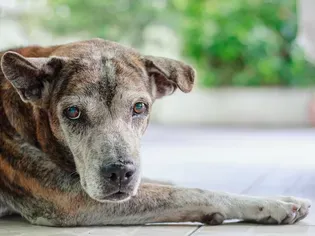How to Identify and Treat Incontinence in Older Dogs
Updated on 04/26/24

Unveiling the Silent Struggles: A Comprehensive Guide to Identifying and Treating Incontinence in Senior Dogs
As our beloved canine companions gracefully enter their golden years, their bodies undergo a myriad of changes, some of which can be both challenging and disconcerting. One such issue that often goes unnoticed is incontinence, a condition characterized by the involuntary release of urine or feces. While many may dismiss this as simply a nuisance, incontinence can significantly impact a dog's quality of life and can also signal underlying health concerns.
Understanding the causes and symptoms of incontinence is crucial for providing appropriate care and support for our aging canine friends. This comprehensive guide will delve into the depths of this issue, empowering you with the knowledge to recognize, treat, and manage incontinence in older dogs.
Unveiling the Underlying Causes
Incontinence can stem from various factors, each requiring specific treatment approaches. Understanding the underlying cause is key to addressing the issue effectively.
1. Age-Related Changes:
As dogs age, their muscles, including those controlling their bladder and bowels, weaken. This can lead to difficulty holding waste, resulting in accidental releases.
Example: A 12-year-old Labrador retriever named Max has recently started leaking urine when he gets excited or stands up.
2. Urinary Tract Infections (UTIs):
UTIs, caused by bacterial infections in the urinary tract, can irritate the bladder and urethra, leading to frequent urination and incontinence.
Example: Maya, a 10-year-old Shih Tzu, has suddenly started urinating more frequently and in small amounts. She also strains to urinate and appears uncomfortable.
3. Prostate Problems:
In male dogs, an enlarged or inflamed prostate gland can obstruct the urethra, making it difficult to urinate. This can lead to incontinence or straining to urinate.
Example: Buddy, an 11-year-old German Shepherd, has been having difficulty urinating and has started leaking urine while lying down.
4. Neurological Disorders:
Conditions such as spinal cord injuries or brain tumors can damage the nerves that control the bladder and bowels, leading to incontinence.
Example: Bella, a 9-year-old Golden Retriever, has recently become incontinent of both urine and feces. She also has difficulty walking and appears disoriented.
5. Medications:
Certain medications, such as diuretics or sedatives, can have side effects that include incontinence.
Example: Oliver, a 13-year-old Dachshund, has started leaking urine after being prescribed a new diuretic for his heart condition.
Recognizing the Telltale Signs
Knowing the signs of incontinence is crucial for early detection and intervention. Here are some common indicators:
* Leaking urine or feces while sleeping
* Accidents in the house
* Frequent urination or straining
* Blood in the urine
* Difficulty starting or stopping urination
* Discomfort or pain while urinating
Managing Incontinence with Compassion
Addressing incontinence requires a multi-pronged approach, including medical treatment, lifestyle modifications, and supportive care.
1. Veterinary Consultation:
A comprehensive veterinary examination is essential to determine the underlying cause of incontinence. Your veterinarian will perform a physical exam, urine analysis, and may recommend additional tests such as X-rays or bloodwork.
2. Medications:
Depending on the cause of incontinence, your veterinarian may prescribe medications such as antibiotics for UTIs, hormone therapy for prostate problems, or muscle relaxants for age-related changes.
3. Diet and Exercise:
Maintaining a healthy weight and providing regular exercise can help strengthen muscles and improve bladder control. Avoid overfeeding or giving your dog excessive treats.
4. Crate Training:
For dogs with severe incontinence, crate training can provide a safe and comfortable space while preventing accidents. Be sure to take your dog out frequently to urinate and defecate.
5. Diapers and Belly Bands:
Absorbent diapers or belly bands can help manage incontinence and prevent accidents. Choose products that are comfortable and leak-proof.
6. Behavioral Modification:
Rewarding your dog for appropriate elimination behaviors can reinforce positive habits. Avoid punishing your dog for accidents, as this can create anxiety and worsen the issue.
The Importance of a Holistic Approach
Treating incontinence in older dogs requires a holistic approach that encompasses medical intervention, lifestyle modifications, and emotional support. By understanding the causes, recognizing the signs, and implementing compassionate management strategies, we can ensure our beloved canine companions maintain a comfortable and dignified life in their golden years. Remember, incontinence is not a sign of weakness or a reason to give up on your furry friend. With patience, care, and professional guidance, you can help your senior dog overcome this challenge and enjoy a fulfilling twilight.
Explore More Pets

Basic Training
Puppy and Baby Introductions

Working Dog Breeds
All About Search and Rescue Dogs

Dog Treatments
Puppy Vaginitis: Signs, Causes and Treatment

Dog Adoption
After More Than 1,200 Days in the Shelter, Coco Goes Home

Basic Training
How to Train Your Puppy to Go on Potty Pads

Hybrid Dog Breeds
The Difference Between a Mutt, Mixed Breed, or Designer Dog?

Dog Treatments
Nail Problems in Dogs

Puppies
7 Reasons Why Two Dogs Are Better Than One